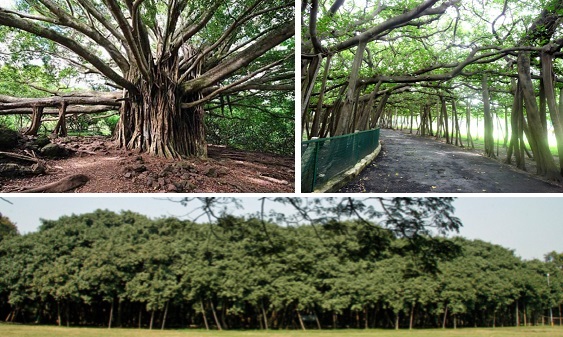Apr 13, 2025
Apr 13, 2025
by Swapna Dutta
Did you know that the botanical garden in Calcutta has a banyan tree that is more than 100 years old with a main trunk that is 4 meters in diameter and has 230 large trunks and nearly 3,500 smaller ones? It spreads over a huge area and is one of Calcutta's sights. All banyan trees send down a great number of shoots from their branches. These take root after they touch the ground and grow into new trunks. As they spread further and further from the original trunk it looks as if they are taking steps and walking away. That is why the banyan is sometimes called 'the walking tree' or 'bahupada', which means 'one with many feet'.

The scientific name of the banyan is Ficus Benghalensis and it grows widely throughout tropical Asia. It is an evergreen tree. The leaves are large and heart-shaped and the berries are bright red. Although people don't eat the berries, birds and monkeys do. The leaves are used as fodder for animals. The tree grows to a height of several meters - 21 or more - and lives for many, many years. When the original trunk grows old and faces decay the tree is supported by the younger ones. That is why the banyan tree is said to symbolize eternal life. It is also said to symbolize the 'Trimurti', with Vishnu as the bark, Shiva as the branches and Brahma as the roots. It is also called 'kalpa vriksha' or 'tree that fulfils your wishes' and is considered sacred by many.
You might be interested to know how the banyan tree got its name. The banyan trees used to be very popular in villages because people gathered and met under the shade of the huge tree. It happened to be the most favorite meeting place of the merchant class (called banias) and they sat there by the hour, discussing business deals. So the tree came to be named after them.
The banyan tree is mentioned in many of the Jataka tales and in many of our mythological stories. Prince Satyavan is said to have died under a banyan tree when his wife Savitri entered into a debate with Yama, the god of death, and won back his life. Even now many Indian women go to worship the banyan tree in the month of May-June to pray for the welfare and long life of their husbands. The tree also has associations with saint Kabir and the scholar Markandeya who took shelter under it on a rainy evening. In fact, people of all religions make use of its great leafy canopy for meetings, meditation or rest.
The wood of the banyan tree is not of much use as timber. But it is used for making things like door panels and boxes. If carefully seasoned it can also be used for simple furniture. The wood of the aerial roots is stronger and more elastic and is used for tent poles, cart yokes and so on. The bark is sometimes used for making paper and ropes.
The banyan tree provides us with lac and shellac. Neither actually belongs to the tree itself but to a kind of insect which lives in the banyan tree. These insects produce a kind of juice or resin which cover the branches completely. Both lac and shellac is made from this resin. Lac is used for making dyes, traditionally used to color wool and silk. Bangles made of lac are also very popular.
Shellac is used for making varnish, waterproof ink for printing and furniture polish. It is also used for leather dressing and for stiffening hats. Apart from these it has a large number of industrial uses.
The milky latex from the stems and leaves of the banyan tree are used for many Ayurvedic, Unani and Siddha medicines. These are mainly used for bruises and applications for relieving pain. The bark is also used for treating illness, specially ulcers. And, of course, the banyan grove is great for playing hide-and-seek!
10-Aug-2019
More by : Swapna Dutta

|
We used to hear as children tales about the great banyan tree in Adayar, Madras and another one called "Pillala Marri" banyan tree in Kurnool district of Andhra Pradesh. Wondering how those compare to the one in the Calcutta's botanical garden. |